If you mount correctly, you save a lot of time during the subsequent specimen preparation. Embedding serves to improve specimen handling as well as to support the edge zone and coatings or the infiltration of cracks, pores and corrosion coatings.
Jump to the desired topic:
Mounting procedures
There are basically two different mounting methods: warm mounting and cold mounting.
Hot mounting
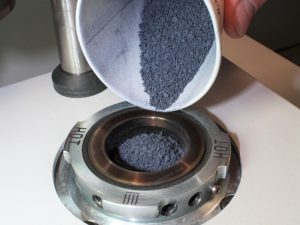
In hot mounting, the specimen is mounted in a mounting press under temperature and pressure with a plastic granulate. Advantages of the process are the high hardness of the mounting material (e.g. glass fiber reinforced) and the good gap-free properties.
Product overview hot mounting agents:
Fiber-glass reinforced bakelite resin
- Phenolic resin base
- Universally applicable
- Price: excellent price-performance ratio
- Hardness according to Shore D: 96.9 ± 0.42 (medium hard)
- Epoxy resin base
- For gap-free mounting
- Ideally suited for hard metals
- Also available extra fine ground
- Hardness according to Shore D: 97.8 ± 0.27 (very hard)
- Acrylic resin base
- For transparent mounting and sample labeling
- Attention: tacked cooling necessary
- Average particle size: < 800 µm
- Hardness according to Shore D: 89.6 ± 0.55 (medium hard)
- Phenolic resin base
- For scanning electron microscopy (electrically conductive)
- Made by Schmitz
Cold mounting
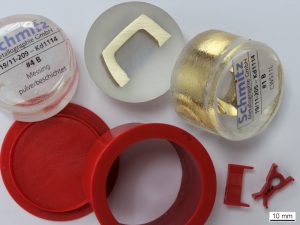
For cold mounting, two components are required, which are mixed in a mixing cup according to the mixing ratio. After stirring, the mixture is poured into the mounting cup. Curing takes place via a chemical reaction (polymerization or polyaddition).
Polymerization is an exothermic reaction, i.e. heat is generated during curing. Depending on the specimen mass, temperatures of up to 90 °C can occur for a short time.
Product overview cold mounting agents:
- Gap formation: yes (as with all fast-curing investment materials)
- Price: best price-performance ratio (“quick and dirty”)
- Extremely low odor
- Mixing ratio: 1:1 by weight (2 liquid components)
- Curing time approx. 20 min
- Hardness according to Shore D:
- Based on highly crosslinked methyl methacrylate
- Green-transparent
- Fast curing
- Mixing ratio: 2:1 by volume (1 powder, 1 liquid component)
- Curing time: approx. 30 minutes
- Can be ground and polished after approx. 45 minutes
- Completely transparent and gap-free curing
- Optimal for target preparations and vacuum infiltrations
- Suitable for SEM
- Hardly any odor
- Mixing ratio: 100:55 by weight (2 liquid components)
- Curing time: 8-12 h at room temperature
- Hardness according to Shore D: 81 ± 1.3
WORK SAFETY // Disposable gloves should be used and protective goggles worn when processing cold mounting agents. Pouring under a fume hood is recommended.
Specimen preparation
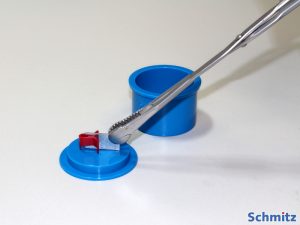
After cutting, the separated specimens should first be deburred. Subsequently, ultrasonic cleaning in a beaker with ethanol is recommended to degrease the specimens. Afterward, the specimens are dried using a microsection dryer. Porous and cracked specimens should be dried for a correspondingly longer time at medium level to allow the ethanol to dry away completely. Further handling of the specimens should only be done with etching tongs or tweezers.
Unmounting
Hot-mounted specimens can be unmounted relatively easily. Heat the sample in the heating cabinet at 220 °C for approx. one hour. The mounting medium swells and the specimen can simply be pressed out in a parallel vice. For absolutely residue-free unmounts, it is recommended to wrap the specimens “like candy” with aluminum foil prior to warm mounting. If 220 °C is too high for your specimens (mounting temperature is 180 °C), you can notch the mounting medium on the lateral surface using a hand-held hacksaw and then crack it in the vice.
Mounting agents
Hot mounting agents
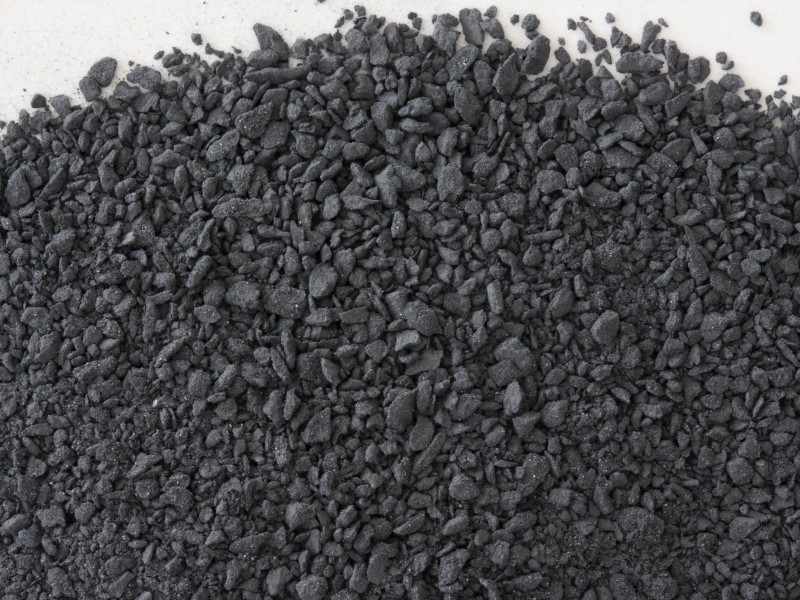
We stock all common hot mounting agents in the container sizes 1 kg, 5 kg and 20 kg. They are heated to 180 °C under pressure.
TIP // Mounting parameters:
Temperature: 180 °C
Holding time at temperature: 2-4 minutes (depending on compression molding die Ø and press manufacturer)
Cooling time: 4 minutes
Pressure: 290 bar
Applies to almost all mounting agents, except for the transparent acrylic mounting agent. Parameters for this can be found below.
Bakelite resin
The hot mouting agent bakelite resin is phenolic resin-based with medium hardness (95.2 ± 0.57 Shore D) for general mounting. Available in black and red.
Fiber-glass reinforced bakelite resin
The fiber-glass reinforced bakelite resin is a phenolic resin-based hot mounting resin with medium hardness (96.9 ± 0.42 Shore D) and has an excellent price/performance ratio. We carry out hot mounting in our own laboratory exclusively with this glass-fiber-reinforced mounting medium (except for hard metals with Epoxy resin EPO). The fiber-glass reinforced bakelite resin is so inexpensive that it is no longer worth filling up with Bakelite.
Epoxy resin EPO
Epoxy resin EPO is a very hard (97.8 ± 0.27 Shore D), black, epoxy resin-based hot mounting agent for gap-free mounting. It is ideally suited for mounting hard metals. It is also available extra fine ground.
Transparent acrylic resin
Our transparent acrylic resin is an hot mounting agent for transparent mountings (and specimen markings) of medium hardness (89.6 ± 0.55 Shore D).
TIP // Mounting parameters:
Temperature: 180 °C
Holding time at temperature: 2-4 minutes (depending on compression molding die Ø and press manufacturer)
Cooling time: 11 minutes
Pressure: 280 bar
Here you must set the program with clocked cooling!
Conductive resin SEM
We produce our conductive resin SEM ourselves. It is an electrically conductive, ultra-fine granular hot mounting agent based on graphite-phenolic resin for electron microscopy.
Cold mounting agents
Cold mounting agents are available from stock in various container sizes. We also offer appropriate accessories for mixing.
VariKEM 100
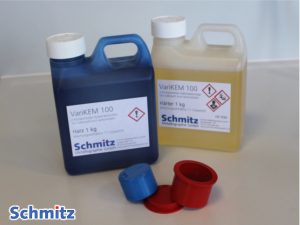
Our VariKEM 100 is a PU-based mounting agent consisting of two liquid components. The components are mixed 1:1 (by weight). It is universally applicable and extremely low-odor. It is cured after approx. 20 minutes. It is characterized by a very good price-performance ratio (“quick and dirty”).
VariKEM 200
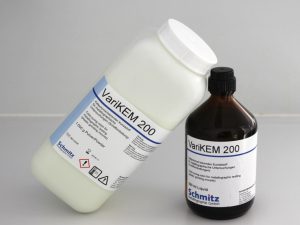
VariKEM 200 is a green-transparent curing universal investment material based on methyl methacrylate for ferrous and non-ferrous alloys. It consists of a powder component and a hardener liquid, the mixing ratio is 2:1 (by volume). The curing time is about 30 minutes. After another 15 minutes, the product is ready for grinding and polishing. VariKEM 200 reaches a polymerization temperature of max. 90 °C.
Epoclear
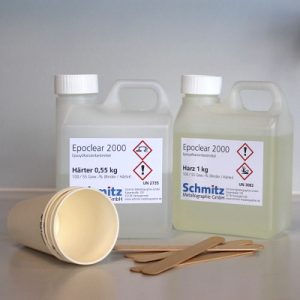
Our Epoclear is an epoxy resin mounting agent and consists of two liquid components mixed in a weight ratio of 100 g binder to 55 g hardener. It is a gap-free, odorless mounting agent that cures slowly over 8-12 hours and is commonly used for vacuum infiltration. The color is transparent. A coloring agent can also be used for better contrasting of cracks and pores.
By the way, to lower the viscosity before pouring the specimens, you can indirectly heat any epoxy resin mounting agent in a warm water bath.
TIP // You can shorten the curing time to 4 hours by placing the cast-in specimens in a heating oven at 50 °C. In our own metallography laboratory, we use the epoxy resin embedding agent as the only cold embedding agent. The workflow is timed so that we photograph, separate and cold mount on the first day and prepare, contrast and microscope the following day. Using our printed specimen labels eliminates the need for time-consuming engraving of specimens due to the transparent mounting medium (Tip Specimen Labeling).
Technovit 4006

Technovit 4006 is a methyl methacrylate-based mounting agent. It consists of two components that are mixed 2 to 1 by volume: a powder and a liquid. Technovit 4006 cures in only 11 minutes (at 22 °C). For a completely transparent and bubble-free cure, this must be carried out in a pressure pot.
Embedding supplies
Clips
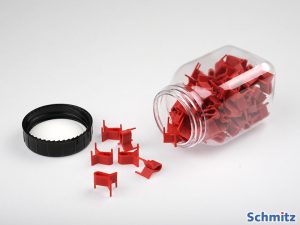
Embedding supplies are suitable for fixing thin specimens such as sheets or CFRP laminates and fibers so that they cannot fall over during pouring. The Monoclips and Trioclips are our own production and are available in the color red. After extensive testing, we selected an extremely chemical-resistant plastic grade that shows no discoloration or swelling even after 10 minutes in hot V2A etching solution. We refrain from using the many bright colors, as these swell up even after one minute of etching in hot V2A etching solution at 70 °C. You can rely on our quality!
To distinguish your samples, you can e.g. align the top clamp with the opening to the left, and the clamps below with the opening to the right.
Also available from us: steel clips (roller springs) made of metal for embedding with high clamping force. Not to be compared with the lax, silver-colored clips.
Mounting cups
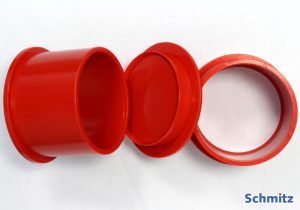
Sturdily designed, 2-part mounting cups made of polyethylene in diameters of 40 and 50 mm. The cover base is extremely low in distortion over the service life. The stable design is optimally suited for mounting agetns that expand during curing. There are 2 phases attached to the mounting mold, so that the specimen is directly deburred on the top as well as the bottom side – this is unique! For easy demolding, we have chosen a plastic grade that is also used for plain bearings.
Other supplies
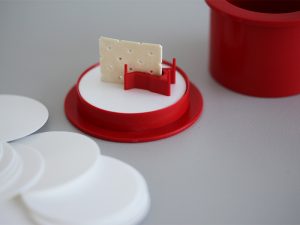
TIP // In our online store you will also find original equipment for cold mounting. It includes petroleum jelly, safety glasses and a weighing scale. This means you can get started with the embedding process straight away.
Accessories
Vacuum infiltration
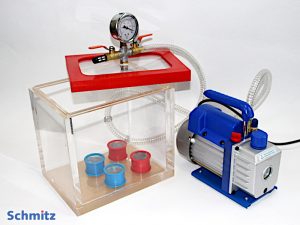
For this purpose, the embedding molds are placed in a vacuum chamber or a desiccator, which is evacuated. This allows the epoxy resin embedding material to infiltrate into the finest cavities. This is particularly important for powder-metallurgical specimens, as it is the only way to determine the true pore content under the optical microscope. Furthermore, cracks and crevices can also be infiltrated. This prevents etchant from being sucked into the gap during etching of the specimen (capillary effect). Vacuum infiltration is also possible with porous corrosion coatings. During preparation, undesirable breakouts can thus be minimized.
Pressure pot
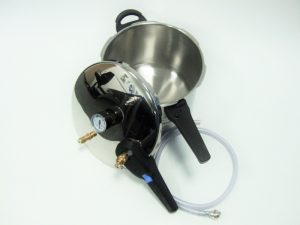
The polymerization of the mounting agent can take place in the pressure pot. For this purpose, it is pressurized to two bar 2-3 times and then completely ventilated again. Adhering air bubbles can thus rise and burst during pressure equalization. We then allow the specimens to cure at 1 bar overpressure. Gap formation can be usefully suppressed, especially with methyl methacrylate-based embedding materials. For the epoxy resin embedding agent, the combination of vacuum infiltration with subsequent curing in the pressure pot is recommended.
Tips & tricks
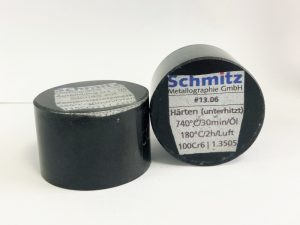
TIP // Specimen labeling:
We always print our specimen labels using a Word template. With a font size of 10 pt, six or more different sample numbers can be assigned depending on the design. This label is then placed on the dark hot mounting agent granules as usual and filled with transparent resin. This eliminates the need for time-consuming engraving and makes deciphering the illegible handwriting of a colleague a thing of the past. This is time-saving for a high volume of samples and looks neat. Within a retention period, the samples can be retrieved very easily.
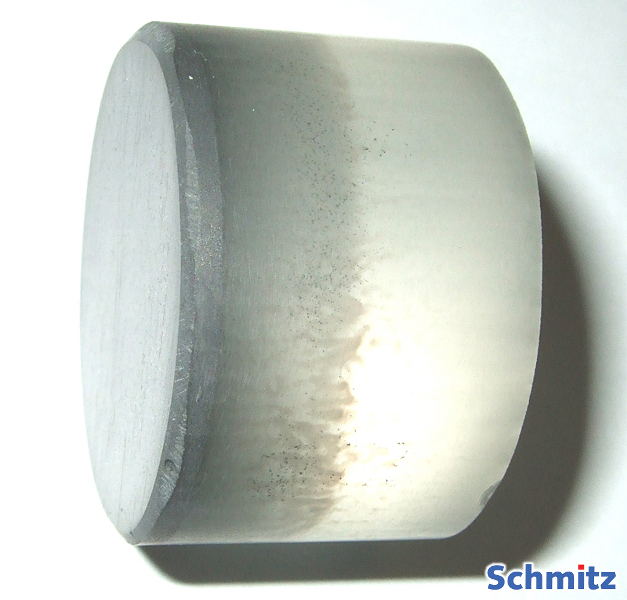
TIP // Embedding of hard metal powder:
You are faced with the task of preparing a powdered sample metallographically. Here we would like to show you a possible procedure using the example of WC-Co carbide powder (powder fraction 0-45 µm grain size). You can also transfer the procedure to any other powder (e.g. ceramic powder). For this purpose, mix an appropriate quantity of our Epoclear cold embedding agent (e.g. 50 g binder, 27.5 g hardener). Now pour 20 g of the ready-mixed mixture into a new mixing beaker and add the same amount of carbide powder. Stir the powder/embedding material mixture well (approx. 1 minute). Pour an approx. 5 mm high layer of this mixture into a prepared and lightly greased cold mounting cup.
Then you can slowly pour on the remaining (pure) mounting agent. It is easiest to let this run into the cup along the wooden stirer to avoid swirling. Curing should be done in the pressure pot (see here for procedure). After curing you will get a sample built up in layers (see photo). You can now prepare the specimen according to a carbide preparation recipe. The grinding times must be adjusted (shortened) according to the purpose. With the help of this preparation recipe, absolutely sharp-edged microsections can be produced.
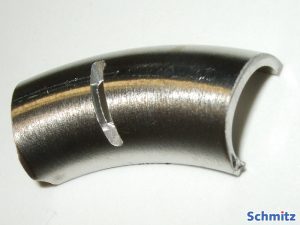
TIP // Cold mounting of a tube segment in longitudinal section:
If, for example, you want to examine the joint weld of two tubes in longitudinal section, you should make a venting cut in the separated test specimen so that the air can escape from under the inside of the tube, thus clearing the way for the mounting agent. To do this, you can saw the tube at one point or drill a vent hole. After pouring in the mounting agent, the specimen should still be vacuum-infiltrated.
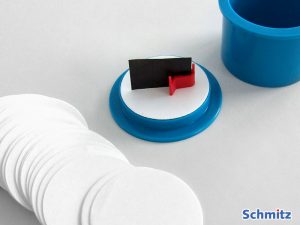
TIP // Self adhesive film prevents floating of light specimens when pouring the cold mounting medium:
To prevent floating of lightweight CFRP laminates, stick a self adhesive film to the ungreased bottom of your cold mounting cup. Simply turn the mounting clamp around (feet up, not down as usual) and then stick the clamp with the smooth side on the self adhesive film. You can then pour on the sample normally. It is best to remove the adhesive foil from the cured specimen using a spatula before grinding.
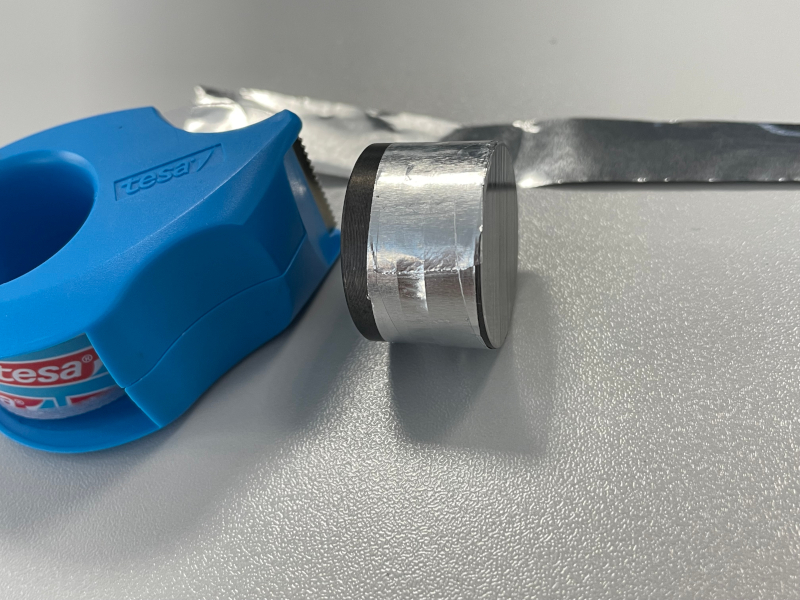
TIP // Increasing contrast on edge-oxidized components (e.g. nitrocarburized):
Nitrocarburized components have a dark, very thin oxide layer on the surface. The contrast to the black embedding medium is very poor. Wrapping with Al foil provides very good contrast enhancement for exact thickness measurement of the entire surface zone. It also ensures high edge sharpness and preservation of the damageable layer during preparation, so that its use can lead to better results even with nitrided specimens.
For this purpose, the cleaned specimen is wrapped as tightly as possible with a strip of aluminum foil before embedding and the foil is fixed with a small piece of adhesive tape. Alternatively, pure Cu foil can also be used for this method; however, aluminum foil is more likely “in the house” and will not interfere with the etching of the specimen.

